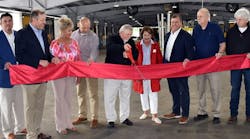For the first time in recent memory, the U.S. transportation infrastructure has become a prominent national issue. Not since the 1950s, when President Dwight D. Eisenhower championed the Interstate Highway System, have politicians in Washington and in state capitals pushed so hard for a coherent transportation policy. “The most pressing problems can sometimes be the dullest,” said Sen. Christopher Dodd (D-CT). “That is, until we are forced to confront the issues, and then they get our attention.”
Dodd was referring to the August collapse of the Interstate 35W Bridge over the Mississippi River, which killed 13 people and injured 100 more. Out of that event came the collective realization that the nation's bridges, tunnels and roads were in worse condition than many people had believed, despite decades of complaints by truck carriers about the continuing deterioration.
While Congress and the Administration have argued for almost eight years about the best way to fund repairs and maintenance, the issue has hit critical mass over the past months with the release of several key studies, a transportation budget request from the President, a Government Accountability Office report (GAO), and position papers by the presidential candidates that address the matter.
In 2005, Congress created a 12-person panel, the National Surface Transportation Policy and Revenue Study Commission, whose purpose was to seek ways to fund the infrastructure ahead of the coming 2009 highway reauthorization bill. The diverse members included DOT Sec. Mary Peters; Steve Odland, chairman and CEO of Office Depot; Patrick E. Quinn, co-chairman and president of U.S. Xpress; and Frank Busalacchi, Secretary of the Wisconsin Dept. of Transportation.
The report, Transportation for Tomorrow, noted that the nation needs to invest at least $225 billion annually for the next 50 years to upgrade the existing transportation network to a good state of repair and to build more advanced facilities that will allow the U.S. to remain competitive. “Without improvements to key goods-movement networks, freight transportation will become increasingly inefficient and unreliable, hampering the ability of American businesses to compete in the global marketplace,” the report noted.
The report went on to detail the areas that needed attention and various possibilities to address them. However, one finding of the report provoked discord among members: “We are recommending that the federal government be a full partner — with states, local governments and the private sector — in addressing the looming transportation crisis. The problem is simply too big for the states and local governments to handle by themselves, even with the help of the private sector. We believe that the federal government must continue to be a major part of the solution.”
Peters, along with two other members, refused to sign the report. She later told Congress that states — not the federal government — should take the lead in funding roads because they know their needs better than Congress. Her position was in line with President George W. Bush's budget proposal to cut federal highway spending by $2 billion from last year.
Not only were some members of Congress outraged, but so were governors, who met for their annual meeting in March. “We are going to ask the federal government, we are going to inspire them, we are going to force them to rebuild our infrastructure,” California Gov. Arnold Schwarzenegger told his fellow governors.
Adding more rancor to the discussion was a recently released GAO report titled Highway Public-Private Partnerships stating that the risks of private ownership of roads may outstrip the benefits, including the likelihood that tolls on privately operated highways will increase to a greater extent than they would on a publicly operated toll road. “Highway public-private partnerships are also potentially more costly to the public than traditional procurement methods, and the public sector gives up a measure of control, such as the ability to influence toll rates.” American Trucking Assns. president and CEO Bill Graves agreed: “It's an important development to have the GAO acknowledge that such funding mechanisms are not in the best interest of the American taxpayers.”
Infrastructure has become part of the presidential debates. So far, both Democratic candidates — Sen. Hillary Clinton and Sen. Barack Obama — have called for large federal investments in the nation's transportation system, saying it not only raises U.S. competitiveness but creates jobs and increases road safety. At press time, Republican nominee Sen. John McCain had not addressed the transportation infrastructure issue.
Infrastructure repair is approaching a crisis level not only because roads and bridges are crumbling, but because the Highway Trust Fund could go broke as early as this summer. President Bush has proposed taking $3.2 billion from transit funds to shore it up, but many call this a shortsighted approach. Rep. James Oberstar (D-MN) said: “Despite the collapse of the I-35W bridge in Minneapolis, despite the newly released report of the National Surface Transportation Policy and Revenue Study Commission, this Administration continues to deny the breadth and depth of our infrastructure crisis.”


